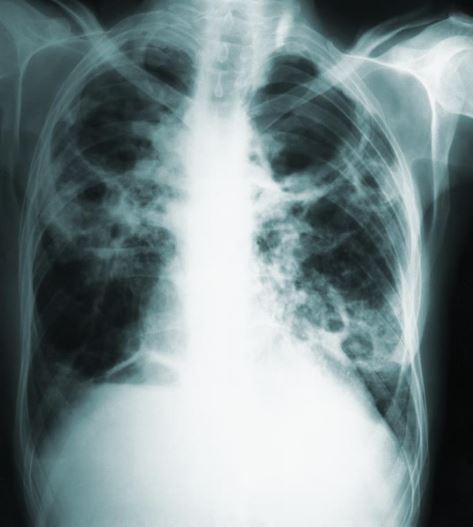The drugs used in the treatment of tuberculosis (TB) vary according to the resistance of the organism to drugs. The first-line drugs used in its treatment are isoniazid, ethambutol, pyrazinamide, and rifampicin. These drugs are given together within the first two months of disease treatment. Then, for the remaining four months, only rifampicin and isoniazid are administered.

X-ray of Tuberculosis Patient
Read Also: Researchers Working To Find New Effective Treatments For Tuberculosis
Rifampicin, one of the vital drugs used in TB management, works by inhibiting the production of RNA in the cell of the bacteria. This leads to the death of the cell. A structural change in the binding site of the drug due to mutation leads to the bacteria’s resistance to the drug.
Isoniazid, on the other hand, acts by interfering with the synthesis of the cell wall of mycobacterium. It does this by suppressing the production of mycolic acid which is important in maintaining the cell wall’s permeability. However, Isoniazid is a prodrug that needs to be activated by an enzyme catalase-peroxidase. Therefore, mutations in katG, which regulates the catalase-peroxidase enzyme, lead to a resistance to the drug.
When resistance to the first-line drugs occurs, second-line drugs are incorporated into the management of the disease. They include drugs like linezolid, levofloxacin, Bedaquiline, Delamanid, and Moxifloxacin. Injectables like Kanamycin and Amikacin are used also.
Poly-resistant tuberculosis is when the organism is resistant to two or more drugs used in first-line TB management apart from Rifampicin and Isoniazid. Mono resistance is said to occur when the organism is resistant to just one of the drugs used in initial TB therapy. Multi-drug-resistant tuberculosis (MDR TB) develops when the mycobacterium does not respond to isoniazid and rifampicin, the two major drugs used in TB management.
Read Also: SMARt751 Brings a Solution to Drug Resistance by Tuberculosis Bacteria in Animal Models
MDR TB with added resistance to either an injectable or fluoroquinolone is called pre-extensively drug-resistant tuberculosis. While MDR TB with resistance to both drugs above is extensively drug-resistant tuberculosis.
The powerful TB second-line drugs
While the second-line drugs are used in the management of resistance, they are more toxic than the first-line drugs. Thus, a study was done by some scientists to check the safety and toxicity of the Bendaquiline-Pretomanid-Linezolid drug combination in the management of drug-resistant tuberculosis.
Bendaquiline is known for its bactericidal ability through the inhibition of ATP generation in bacteria. It has the side effects of headache, joint pain, and nausea. It can also be used together with other anti-TB drugs. It is potent in the management of MDR TB.
Linezolid is a bacteriostatic drug that can be used in the treatment of diseases like pneumonia. It is also useful in the treatment of drug-resistant tuberculosis. Its adverse effects include headaches, vomiting, abdominal pain, and anemia.
Pretomanid was recently endorsed for use in drug-resistant TB management by the FDA in 2019. Its side effects include anemia, itching, hives, shortness of breath, and dizziness.
A combination of these three drugs, Linezolid, Bedaquiline, and Pretomanid has proven to be efficacious in the treatment of drug-resistant tuberculosis. However, when linezolid of 1200mg is administered, the side effects are numerous. Therefore, scientists researched to determine the dosage that will be effective with minimal side effects as this was previously unknown.
Read Also: Antibiotics: Two Antibacterial Compounds Effective Against Resistant Tuberculosis Discovered
About 181 participants with pre-extensively drug-resistant tuberculosis (pre-XDR TB), extensively drug-resistant tuberculosis (XDR TB), or rifampicin-resistant tuberculosis were recruited. Those that received a lower dose of linezolid, 600 mg, for 26 weeks had a better outcome, lesser side effects, and lesser dose modifications than those that received the same dose for shorter periods, or those that received higher doses.
Clinical significance
The incidence of drug-resistant tuberculosis is on the increase. Thereby, rendering the initial drugs used in the treatment of tuberculosis ineffective. Thus, the need for second-line drugs in TB management. The Bedaquiline-Linezolid-Pretomanid combination is a potent therapy against this development.
This study helps to answer the question of the effective dose combination of the drugs with fewer side effects and dose modifications. Thus, the quality of life of patients with this disease can be improved and their healing facilitated.
Conclusion
The importance of this study cannot be overemphasized. Though the mycobacterium is becoming resistant to drugs, science is also evolving to effectively combat it. Giving the right dose of drugs will not only combat the disease but also, reduce the adverse effects.
Read Also: Vitamin D Can Help Treat Multi-Drug Resistant Tuberculosis
References
Bedaquiline–Pretomanid–Linezolid Regimens for Drug-Resistant Tuberculosis | NEJM
FEEDBACK:



